
The Pentatomoidea are a superfamily of insects in the Heteroptera suborder of the Hemiptera order. As Hemiptera, they share a common arrangement of sucking mouthparts. The roughly 7000 species under Pentatomoidea are divided into 21 families. Among these are the stink bugs and shield bugs, jewel bugs, giant shield bugs, and burrower bugs.

Pentatomidae is a family of insects belonging to the order Hemiptera, generally called shield bugs or stink bugs. Pentatomidae is the largest family in the superfamily Pentatomoidea, and contains around 900 genera and over 4700 species. As hemipterans, the pentatomids have piercing sucking mouthparts, and most are phytophagous, including several species which are severe pests on agricultural crops. However, some species, particularly in the subfamily Asopinae, are predatory and may be considered beneficial.
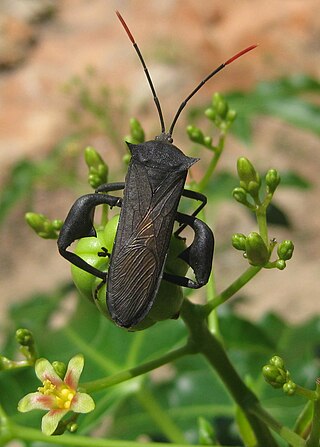
Coreidae is a large family of predominantly sap-sucking insects in the Hemipteran suborder Heteroptera. The name "Coreidae" derives from the genus Coreus, which derives from the Ancient Greek κόρις (kóris) meaning bedbug.
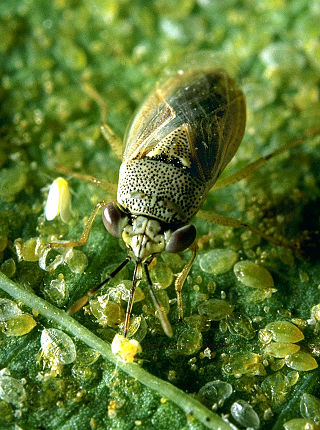
Geocoris is a genus of insects in the family Geocoridae. Commonly known as big-eyed bugs, the species in Geocoris are beneficial predators, but are often confused with the true chinch bug, which is a pest. There are more than 140 described species in Geocoris.

Brochymena is a genus of insects, sometimes known as the rough stink bugs. They belong to the shield bug family, and are easily confused with the similar-looking brown marmorated stink bug.

Cosmopepla lintneriana, the twice-stabbed stink bug, is a species of insect in the family Pentatomidae. Cosmopepla lintneriana was first described in 1798 by Johan Christian Fabricius as Cimex carnifex, and then again in 1865 by Thomas Say as Cosmopepla bimaculata. Cosmopepla lintneriana is hosted by a variety of plants, including milk thistle, echinacea, asparagus, oats, mint and goldenrod, and is widespread throughout North America, from Canada to Mexico. Adult C. lintneriana are black with a red, orange, or yellow band across the pronotum and a short red stripe along the midline, and two red spots at the apex of the scutellum. Nymph coloration ranges from red to white with black markings that change as they grow.
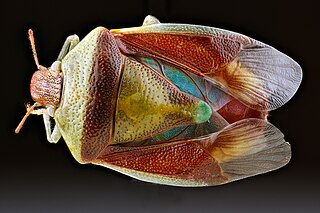
Banasa is a genus of plant feeding stink bugs in the family Pentatomidae.
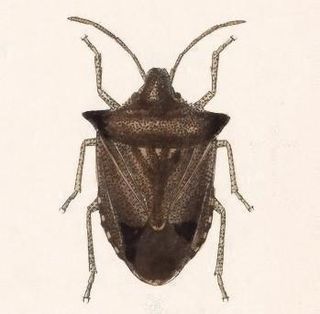
Euschistus is a genus of stink bugs in the family Pentatomidae. There are at least 20 described species in Euschistus.

Agallia is a genus of leafhoppers in the family Cicadellidae. There are about 8 described species in Agallia. During courtship displays and mating, both males and females of the species A. constricta alternate in making ticking sounds.
Tepa is a genus of stink bugs in the family Pentatomidae. There are about 6 described species in Tepa.

Homaemus is a genus of shield-backed bugs in the family Scutelleridae. There are about 5 described species in Homaemus.
Lygidea is a genus of plant bugs in the family Miridae. There are about 10 described species in Lygidea.
Okanagana is a genus of cicadas in the family Cicadidae. There are at 58 described species in Okanagana.

Carpocorini is a tribe of stink bugs in the family Pentatomidae. There are more than 100 genera in Carpocorini.

Podisus is a genus of predatory stink bugs in the family Pentatomidae. There are at least 20 described species in Podisus.

Irbisia is a genus of plant bugs in the family Miridae. There are more than 20 described species in Irbisia. These black insects are 5–8 mm in length. They are also called black grass bugs as they are common in spring grasses.

Thyanta is a genus of stink bugs in the family Pentatomidae. There are about 19 described species in Thyanta.

Hymenarcys is a genus of stink bugs in the family Pentatomidae. There are about five described species in Hymenarcys.
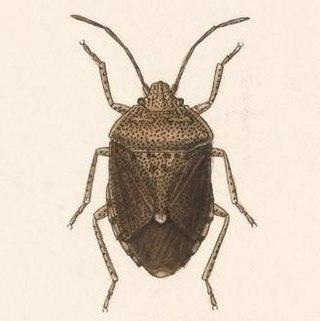
Trichopepla is a genus of stink bugs in the family Pentatomidae. There are about six described species in Trichopepla.
Apateticus is a genus of predatory stink bugs in the family Pentatomidae. There are about seven described species in Apateticus.



















